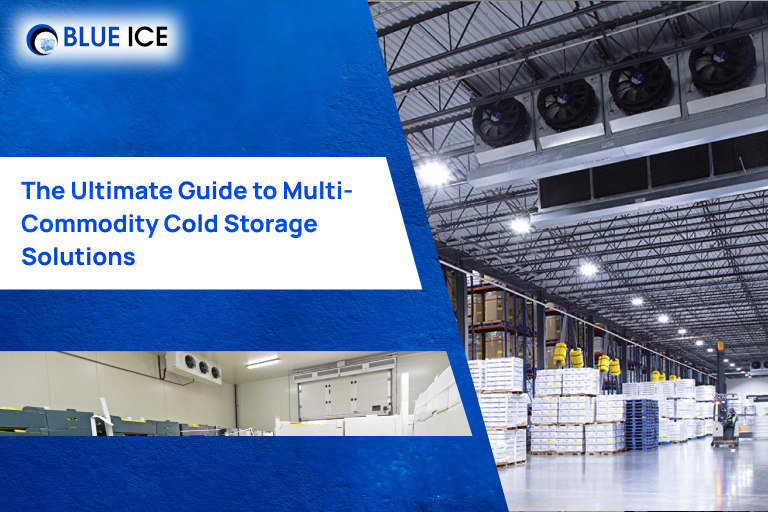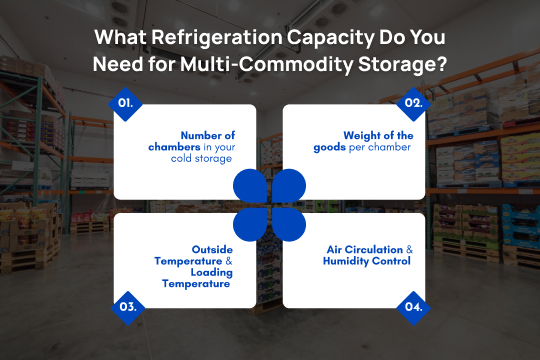
The Ultimate Guide to Multi-Commodity Cold Storage Solutions
If you have been considering setting up a multi-commodity cold storage lately, you might be having a lot of questions!
Being in the food or pharmaceutical industry, we all know the importance of temperature-controlled storage. Even the slightest change in the temperature, and you would risk your material going to waste.
So, whether you're storing fresh fruits, vegetables, dairy products, or pharmaceutical products, having an indoor unit for cold storage can be a game changer.
But how do you know -
- Which cold chamber design would be the best for you?
- What would a cold storage setup cost?
- Should you go with ammonia vs freon for cold storage?
- What would be the cold storage electricity consumption?
- And what cold storage refrigeration capacity should you go for?
Well, we will give answers to all these questions while also sharing the knowledge about best cold storage practices, cold storage insulation techniques, how to reduce cold storage electricity bills, and the approximate cost of 5000 MT cold storage.
Also read: What is the scope of a cold storage business in India?
Let’s first understand what the different types of products are that you can store in a multi-commodity cold storage.
What Types of Products Can Be Stored in a Multi-Commodity Cold Storage?

The beauty of multi-commodity cold storage is its versatility. It’s not just for one specific type of product; you can use it as a solution for diverse products that need temperature-controlled environments to maintain quality.
Here’s what you can store with a multi-commodity cold storage:
- Fresh produce: Vegetables, fruits, and potatoes
- Spices: Dry Red Chili, Turmeric, etc.
- Dairy products: Milk, Cheese, Curd, Paneer
- Frozen items: Ice cream, frozen peas, poultry, seafood
- Grains and pulses: Pulses, Lentils, Jaggery
- Dry fruits: Raisins, Cashews
- Ready-to-eat meals and much more
In short, you can store any perishable item that requires artificial cooling (ranging from -25°C to 25°C).
So, the next question arises - how do you figure out the space you would require according to your cold storage refrigeration capacity? Don’t worry! We’ve got you covered!
Let’s get an answer to that in the next section.
How Much Area Do You Need for a 5000 MT Multi-Commodity Cold Storage?
If you are thinking of setting up 5000MT, here’s a rough estimation you can have for yourself:
- For each ton of material, you’ll need about 120 cubic feet of space.
- A 5000 MT facility would require roughly 12,000 square feet of storage space alone. But wait, that’s not all.
Moreover, considering height and the design of the facility (e.g., multi-story construction), the total space you may require could be around 24,000 square feet.
This gives you enough room for product storage while allowing for proper cold storage air circulation and efficient refrigeration.
Ammonia vs. Freon: Which Is Better for Cold Storage?
Now, let’s explore the aspect of ammonia vs freon for cold storage, as it’s one of the most critical decisions you need to make while choosing the right refrigerant.
- If you have smaller storage units (under 2500 MT), you should go for Freon, as it’s easier to manage and doesn’t require as much maintenance. It’s a good choice for small to medium operations.
- Ammonia, on the other hand, is ideal for larger facilities (above 2600 MT). Though it requires more maintenance and operator training, ammonia is more energy-efficient and less expensive to operate in the long run.
So which one should you choose?
Well, it depends on your storage needs and budget. If your facility is 5000 MT, ammonia would likely be your best bet. It balances lower operational costs with greater efficiency, making it a better option for larger capacities.
What Refrigeration Capacity Do You Need for Multi-Commodity Storage?

Let’s suppose you have decided on which multi-commodity storage innovation and solution you want to go with. The next question you would have would be how much cold storage refrigeration capacity you would need to maintain the optimal temperature.
The answer depends on various factors like:
- Number of chambers in your cold storage
- Weight of the goods per chamber
- Outside temperature and loading temperature and
- Air circulation and humidity control
To give you some rough idea, we can say that for a 5000 MT cold storage (with 4 chambers), the required refrigeration capacity might be about 120 TR (tons of refrigeration) at an evaporation temperature of -5°C.
The more precise your refrigeration system is, the better you can control energy consumption while maintaining the perfect environment for your stored goods.
In short, it’s all about getting the right balance between energy usage and maintaining product quality.
How Can You Reduce Electricity Consumption in Cold Storage?
Lately, if you have been wondering how to reduce cold storage electricity bills, we have got you covered!
High electricity consumption can be one of the biggest operational costs while running a multi-commodity cold storage facility.
But don’t worry; there are ways in which you can save energy while still keeping your products at the right temperature.
Here’s how you can do it -
- Insulation
Ensure all the walls, floors, and roofs are insulated effectively to prevent heat transfer. Better insulation = less energy spent.
- Efficient Indoor Units
The indoor units for cold storage (evaporators) play a crucial role in keeping your energy bills low. Make sure you're selecting units that match your cold storage’s size and capacity.
- Roof Insulation
A huge amount of energy can escape through the roof if you don’t keep it insulated properly. It’s always recommended that you invest in high-quality roofing materials.
- Seal Leaks
Even small leaks in the insulation can lead to huge energy losses. Regularly check your facility for air leaks.
What Role Does the Indoor Unit Play in Saving Electricity?

In the above section on how to reduce cold storage electricity bills, we just talked about efficient indoor units for cold storage.
Did you know that indoor units can account for up to 25% of the total energy consumption in a cold storage facility?
So, it’s clear that when you choose the right one, it can definitely impact your electricity bills.
Here are some of the most important factors that affect energy efficiency:
- Pitch of the evaporator: Make sure you are choosing the correct square pitch for optimal airflow and reducing the load on your system.
- Fan power: You also need to make sure that you have energy-efficient fans that don’t consume unnecessary power.
- Surface area and air volume: Lastly, make sure surface area and air volume is balanced rightly so that the system can run at full capacity without overworking.
When you make sure of all of these factors, you don't just cut your costs but also improve overall product quality.
How Important is Cold Storage Air Circulation to Maintain Product Quality?
Now, once you have bought a multi-commodity cold storage, you also need to keep in mind that good insulation and air flow matter a lot to maintain product quality.
Having improper air circulation and not following the cold storage insulation techniques may result in -
- Hotspots that damage the quality of stored goods, and
- Uneven cooling, which can reduce shelf life, especially for delicate products like fruits and vegetables.
To make sure your multi-commodity cold storage facility maintains the product quality, make sure -
- The air is circulated evenly across the room.
- Your air velocity and humidity control are optimized for the specific products being stored.
We are sure; by following these cold storage insulation techniques, you will be able to keep product quality to its optimal level.
How to Minimize Weight Loss in Multi-Commodity Cold Storage?
Let’s be honest - weight loss in cold storage is a real problem. And it happens because of the moisture evaporation.
If you are storing products like potatoes, vegetables, and fruits, you need to maintain the right humidity levels to avoid weight loss.
Here’s what you can do to maintain weight of products -
- Use efficient indoor units with optimal humidity control.
- Choose products that are suited for the temperature and humidity levels in the cold storage.
- Regularly monitor and adjust for changes in airflow and temperature.

How Much Does It Cost to Set Up a Multi-Commodity Cold Storage?
Finally, you’re probably wondering, how much will all this cost?
The cost of setting up a 5000 MT multi-commodity cold storage typically ranges from Rs. 10,000 to Rs. 18,000 per MT, depending on the design, refrigeration capacity, and location.
Keep in mind that we have not counted land cost in the above calculations. There’s no doubt that investing in good cold storage chamber design can provide a long-term solution for you to preserve perishable goods while optimizing energy consumption.
Conclusion: Is Multi-Commodity Cold Storage the Right Investment for You?
Well, no one can deny the fact that cold storage is no longer just a "nice-to-have" asset but it’s a critical infrastructure for businesses dealing with perishable goods.
By selecting the right system, you can optimize energy efficiency while maintaining the product quality as well.
So, whether you’re storing fruits, dairy products, or frozen foods, investing in a multi-commodity cold storage solution will bring you and your business significant benefits.
Get in touch with our team today to set up your multi-commodity cold storage today!
Frequently Asked Questions
The multi-commodity cold storage solution is designed to store various products like fruits, vegetables, dairy, meat, and pharmaceuticals under optimal temperature conditions.
It helps maintain product quality, extend shelf life, and reduce spoilage by providing the right temperature and humidity control for different commodities.
Products such as fresh produce, frozen foods, beverages, pharmaceuticals, and floral items can be efficiently stored in a multi-commodity cold storage system.
